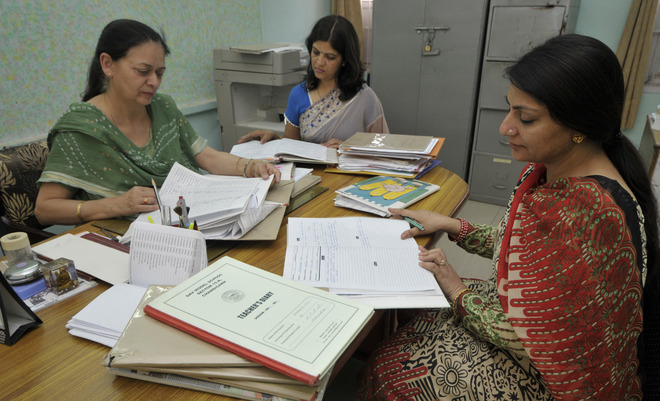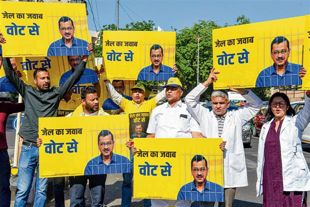
The workload of teachers has increased tremendously with more descriptive indicators on which they need to assess each student Tribune photo: Pradeep Tewari
Introduced as one of the most progressive developments in the school education in India, the objective of the Continuous and Comprehensive Evaluation System is to reduce students' stress of exams and to have a uniform and comprehensive system of education for children all across the country. Along with these, its implementation encompasses — awarding grades instead of marks through a series of curricular and extra-curricular evaluations, along with academics, and measuring every possible ability (scholastic and non-scholastic) of students from innovation, dexterity, teamwork, public speaking, behaviour to steadiness. After more than five years of it being implemented in schools in India, why do people feel the pain of having to go through with it, more than its benefits? Where did it go wrong when it had all the good intentions to begin with?
There are some very obvious pitfalls in which the CCE system finds itself caught. First things first, the introduction of it was not supported by sufficient due diligence that should have gone behind such an ambitious transition. The intensive training that the schools, teachers and other stakeholders required was missing initially leaving everybody guessing about the changed system.
Teachers or record keepers
The worst caught were the ones who had the direct impact of the system — students and teachers. While students are made to jump from one evaluation to another assessment, the plight of teachers is no better. Their work has increased tremendously with more descriptive indicators on which they need to assess each and every student. After having seen the working of CCE system in action now, there is no ambiguity that some systemic changes needed to be in place in order to make use of this evaluation procedure. The first and most important among them is to have reduced teacher-student ratio. If a teacher is to observe, understand and guide the students constructively then ideally there cannot be more than 20 students to a teacher. When a teacher is expected to maintain a number of diagnostic records of every student from basic profile to highly intrusive anecdotal records, it is not viable for one teacher to get the same implemented in the right spirit with class size ranging from 40 to 60 students in a class.
Too much of record keeping leaves teachers with no breathing space, shares Sneha (name changed) a primary school English teacher. She says, “The focus has shifted to putting down the grades on everything. We are missing the fun of free-form interaction with students without worrying about completing our grading procedures.”
A principal of one of the schools in Chennai says, “CCE system has reduced a teacher to a record keeper as a teacher is forced to spend more time recording things than teaching.” With number of heads on which the students are to be evaluated has increased exponentially, where is the scope, time and energy for an unhindered interactive educative sessions in class?
As teachers are overwhelmed with more of documentation and reporting, there are bound to be many areas that get compromised on its altar and constructive collective discussions on lesson planning among/across subject teachers is one of them. In order to work towards the aspiration of bringing in more inter-disciplinary areas and subjects starting from the school level, adequate resources in terms of teacher's time should be allocated to the same. Additionally, to keep the education field vibrant with energy and fresh ideas, continuous learning of teachers through workshops, courses and discussions should form an indispensable part of the holistic education program.
While the idea to encourage students to bloom in whichever field they feel their calling lies, is a great initiative and should be the right way to go about guiding and mentoring students. However, the new system starts ailing and failing when the quality in everything goes for a toss as the same system clutters a mentor's mind with pushes and pulls for ticking the unending checklist.



























